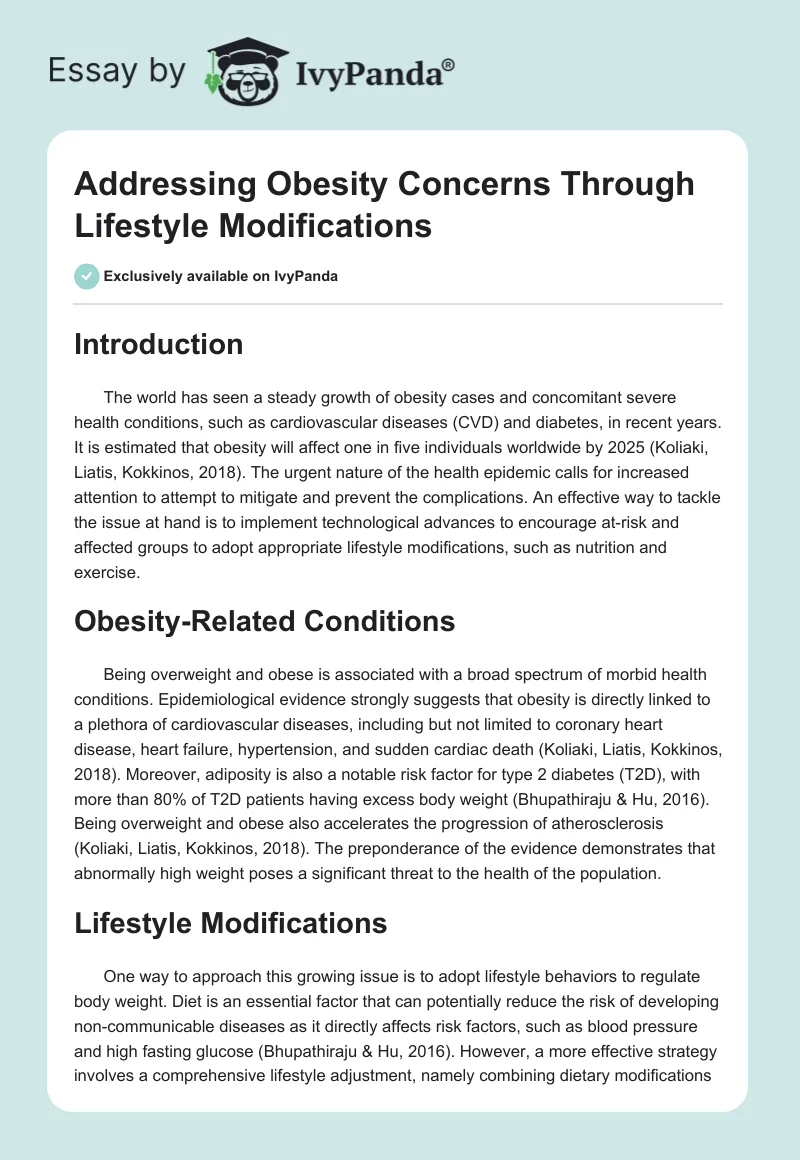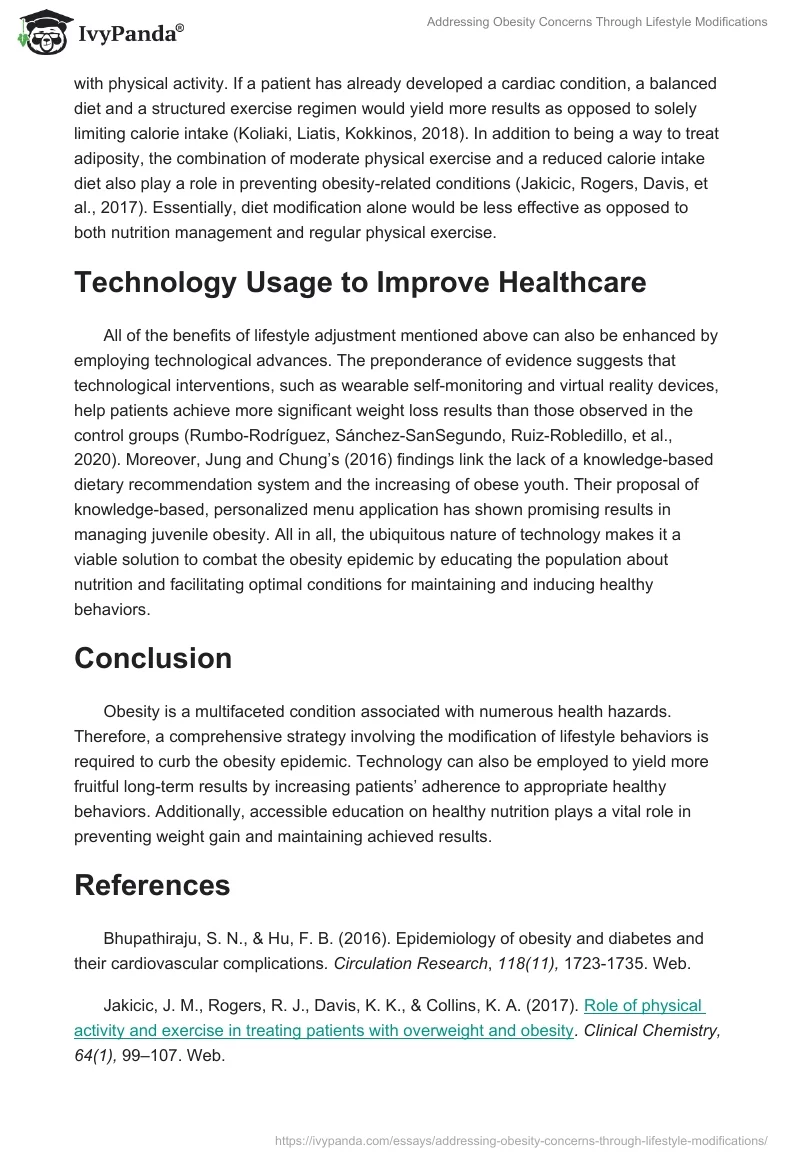Introduction
The world has seen a steady growth of obesity cases and concomitant severe health conditions, such as cardiovascular diseases (CVD) and diabetes, in recent years. It is estimated that obesity will affect one in five individuals worldwide by 2025 (Koliaki, Liatis, Kokkinos, 2018). The urgent nature of the health epidemic calls for increased attention to attempt to mitigate and prevent the complications. An effective way to tackle the issue at hand is to implement technological advances to encourage at-risk and affected groups to adopt appropriate lifestyle modifications, such as nutrition and exercise.
Obesity-Related Conditions
Being overweight and obese is associated with a broad spectrum of morbid health conditions. Epidemiological evidence strongly suggests that obesity is directly linked to a plethora of cardiovascular diseases, including but not limited to coronary heart disease, heart failure, hypertension, and sudden cardiac death (Koliaki, Liatis, Kokkinos, 2018). Moreover, adiposity is also a notable risk factor for type 2 diabetes (T2D), with more than 80% of T2D patients having excess body weight (Bhupathiraju & Hu, 2016). Being overweight and obese also accelerates the progression of atherosclerosis (Koliaki, Liatis, Kokkinos, 2018). The preponderance of the evidence demonstrates that abnormally high weight poses a significant threat to the health of the population.
Lifestyle Modifications
One way to approach this growing issue is to adopt lifestyle behaviors to regulate body weight. Diet is an essential factor that can potentially reduce the risk of developing non-communicable diseases as it directly affects risk factors, such as blood pressure and high fasting glucose (Bhupathiraju & Hu, 2016). However, a more effective strategy involves a comprehensive lifestyle adjustment, namely combining dietary modifications with physical activity. If a patient has already developed a cardiac condition, a balanced diet and a structured exercise regimen would yield more results as opposed to solely limiting calorie intake (Koliaki, Liatis, Kokkinos, 2018). In addition to being a way to treat adiposity, the combination of moderate physical exercise and a reduced calorie intake diet also play a role in preventing obesity-related conditions (Jakicic, Rogers, Davis, et al., 2017). Essentially, diet modification alone would be less effective as opposed to both nutrition management and regular physical exercise.
Technology Usage to Improve Healthcare
All of the benefits of lifestyle adjustment mentioned above can also be enhanced by employing technological advances. The preponderance of evidence suggests that technological interventions, such as wearable self-monitoring and virtual reality devices, help patients achieve more significant weight loss results than those observed in the control groups (Rumbo-Rodríguez, Sánchez-SanSegundo, Ruiz-Robledillo, et al., 2020). Moreover, Jung and Chung’s (2016) findings link the lack of a knowledge-based dietary recommendation system and the increasing of obese youth. Their proposal of knowledge-based, personalized menu application has shown promising results in managing juvenile obesity. All in all, the ubiquitous nature of technology makes it a viable solution to combat the obesity epidemic by educating the population about nutrition and facilitating optimal conditions for maintaining and inducing healthy behaviors.
Conclusion
Obesity is a multifaceted condition associated with numerous health hazards. Therefore, a comprehensive strategy involving the modification of lifestyle behaviors is required to curb the obesity epidemic. Technology can also be employed to yield more fruitful long-term results by increasing patients’ adherence to appropriate healthy behaviors. Additionally, accessible education on healthy nutrition plays a vital role in preventing weight gain and maintaining achieved results.
References
Bhupathiraju, S. N., & Hu, F. B. (2016). Epidemiology of obesity and diabetes and their cardiovascular complications. Circulation Research, 118(11), 1723-1735. Web.
Jakicic, J. M., Rogers, R. J., Davis, K. K., & Collins, K. A. (2017). Role of physical activity and exercise in treating patients with overweight and obesity. Clinical Chemistry, 64(1), 99–107. Web.
Jung, H., & Chung, K. (2016). Knowledge-based dietary nutrition recommendation for obese management.Information Technology and Management, 17(1), 29-42. Web.
Koliaki, C., Liatis, S., & Kokkinos, A. (2018). Obesity and cardiovascular disease: revisiting an old relationship. Metabolism, 92, 98-107. Web.
Rumbo-Rodríguez, L., Sánchez-SanSegundo, M., Ruiz-Robledillo, N., Albaladejo-Blázquez, N., Ferrer-Cascales, R., & Zaragoza-Martí, A. (2020). Use of technology-based interventions in the treatment of patients with overweight and obesity: A systematic review. Nutrients, 12(12), 3634. Web.


